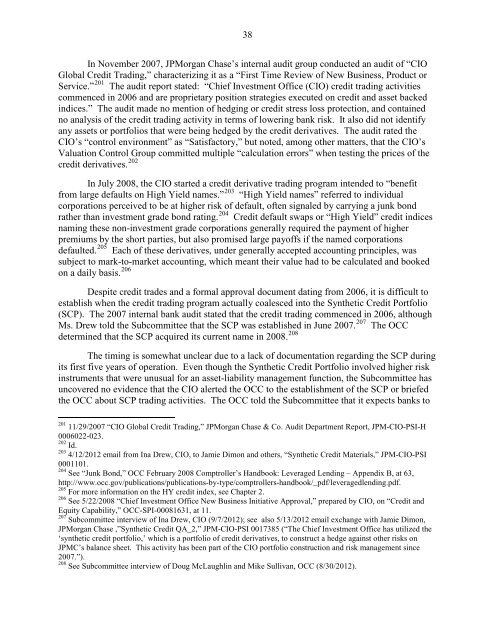JPMORGAN CHASE WHALE TRADES: A CASE HISTORY OF DERIVATIVES RISKS AND ABUSES
JPMORGAN CHASE WHALE TRADES: A CASE HISTORY OF DERIVATIVES RISKS AND ABUSES
JPMORGAN CHASE WHALE TRADES: A CASE HISTORY OF DERIVATIVES RISKS AND ABUSES
You also want an ePaper? Increase the reach of your titles
YUMPU automatically turns print PDFs into web optimized ePapers that Google loves.
38<br />
In November 2007, JPMorgan Chase’s internal audit group conducted an audit of “CIO<br />
Global Credit Trading,” characterizing it as a “First Time Review of New Business, Product or<br />
Service.” 201 The audit report stated: “Chief Investment Office (CIO) credit trading activities<br />
commenced in 2006 and are proprietary position strategies executed on credit and asset backed<br />
indices.” The audit made no mention of hedging or credit stress loss protection, and contained<br />
no analysis of the credit trading activity in terms of lowering bank risk. It also did not identify<br />
any assets or portfolios that were being hedged by the credit derivatives. The audit rated the<br />
CIO’s “control environment” as “Satisfactory,” but noted, among other matters, that the CIO’s<br />
Valuation Control Group committed multiple “calculation errors” when testing the prices of the<br />
credit derivatives. 202<br />
In July 2008, the CIO started a credit derivative trading program intended to “benefit<br />
203<br />
from large defaults on High Yield names.” “High Yield names” referred to individual<br />
corporations perceived to be at higher risk of default, often signaled by carrying a junk bond<br />
rather than investment grade bond rating. 204 Credit default swaps or “High Yield” credit indices<br />
naming these non-investment grade corporations generally required the payment of higher<br />
premiums by the short parties, but also promised large payoffs if the named corporations<br />
defaulted. 205 Each of these derivatives, under generally accepted accounting principles, was<br />
subject to mark-to-market accounting, which meant their value had to be calculated and booked<br />
on a daily basis. 206<br />
Despite credit trades and a formal approval document dating from 2006, it is difficult to<br />
establish when the credit trading program actually coalesced into the Synthetic Credit Portfolio<br />
(SCP). The 2007 internal bank audit stated that the credit trading commenced in 2006, although<br />
207<br />
Ms. Drew told the Subcommittee that the SCP was established in June 2007. The OCC<br />
determined that the SCP acquired its current name in 2008. 208<br />
The timing is somewhat unclear due to a lack of documentation regarding the SCP during<br />
its first five years of operation. Even though the Synthetic Credit Portfolio involved higher risk<br />
instruments that were unusual for an asset-liability management function, the Subcommittee has<br />
uncovered no evidence that the CIO alerted the OCC to the establishment of the SCP or briefed<br />
the OCC about SCP trading activities. The OCC told the Subcommittee that it expects banks to<br />
201 11/29/2007 “CIO Global Credit Trading,” JPMorgan Chase & Co. Audit Department Report, JPM-CIO-PSI-H<br />
0006022-023.<br />
202 Id.<br />
203 4/12/2012 email from Ina Drew, CIO, to Jamie Dimon and others, “Synthetic Credit Materials,” JPM-CIO-PSI<br />
0001101.<br />
204 See “Junk Bond,” OCC February 2008 Comptroller’s Handbook: Leveraged Lending – Appendix B, at 63,<br />
http://www.occ.gov/publications/publications-by-type/comptrollers-handbook/_pdf/leveragedlending.pdf.<br />
205 For more information on the HY credit index, see Chapter 2.<br />
206 See 5/22/2008 “Chief Investment Office New Business Initiative Approval,” prepared by CIO, on “Credit and<br />
Equity Capability,” OCC-SPI-00081631, at 11.<br />
207 Subcommittee interview of Ina Drew, CIO (9/7/2012); see also 5/13/2012 email exchange with Jamie Dimon,<br />
JPMorgan Chase ,”Synthetic Credit QA_2,” JPM-CIO-PSI 0017385 (“The Chief Investment Office has utilized the<br />
‘synthetic credit portfolio,’ which is a portfolio of credit derivatives, to construct a hedge against other risks on<br />
JPMC’s balance sheet. This activity has been part of the CIO portfolio construction and risk management since<br />
2007.”).<br />
208 See Subcommittee interview of Doug McLaughlin and Mike Sullivan, OCC (8/30/2012).



